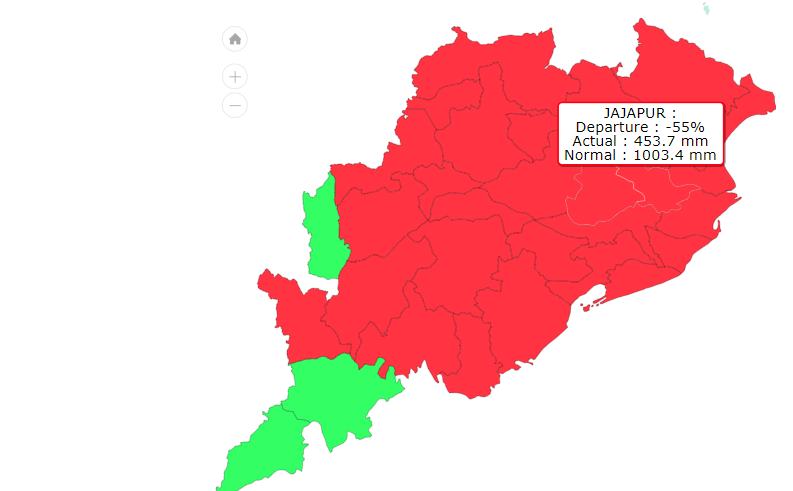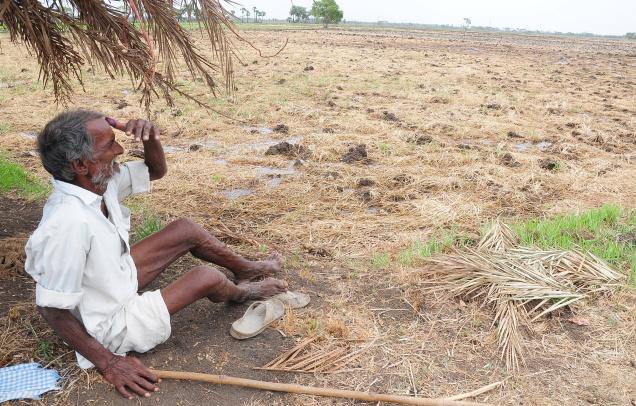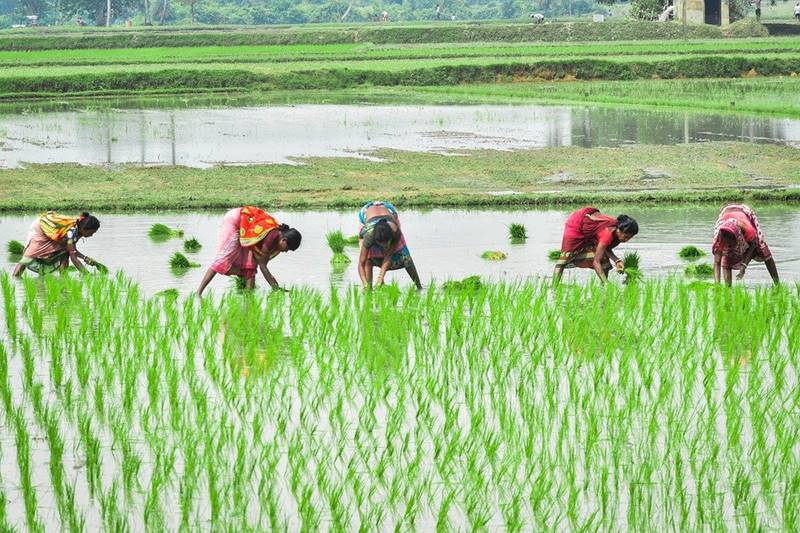Large-scale deficient monsoon rainfall across Odisha triggers fear of drought
In the monsoon season this year, while several states are struggling with floods, Odisha is preparing for a drought year as 27 of its total 30 districts have received deficient rainfall and farmers are staring at huge crop losses.


Drought in Odisha generally occurs during kharif season and is harmful mainly to the paddy crops. Pic: Wikimedia Commons
With only six more weeks of the southwest monsoon season left, 27 of the total 30 districts in Odisha are facing ‘deficient’ rainfall triggering fear of drought in the state. The three districts that officially fall under the category of ‘normal’ rainfall have also reported a negative departure in rainfall.
Predictably, farmers in the eastern state are worried and staring at huge losses and a difficult year ahead.
“Sab sookh gaya. Jameen phat gaya hai. (The crops have dried out. The land is parched and cracked). There was no rainfall in August. Farmers cannot even draw water from ponds, as water bodies have also dried up,” Saroj Mohanty, a farmer leader and spokesperson of Paschim Odisha Krushak Sangathan Samanvay Samiti, a non-profit working for farmers’ rights in the state, told Gaon Connection.
“If it does not rain in the first week of September, crops will be completely destroyed. Farmers will be forced to lose their cattle, Mohanty added. “Even if water is available in some water bodies, most small and marginal farmers do not have the financial means to hire pumpsets and afford diesel cost to lift water and irrigate their fields,” the farmer leader added.

In view of the deficient rainfall situation in the state, Odisha Chief Secretary Suresh Kumar Mahapatra reviewed the rainfall, crop coverage, crop conditions with the district collectors of all 30 districts today on August 23. An emergency action plan is being prepared.
Deficient rainfall in monsoon season
Since the beginning of the monsoon season, between June 1 and August 23, Jajpur and Bhadrak districts have reported the highest rainfall departure of minus 55 per cent and minus 51 per cent, respectively.

In the same period, several other districts such as Balangir (minus 44 per cent), Angul (minus 40 per cent), Kendujhar (minus 43 per cent), Kalahandi (minus 39 per cent), etc have also reported a huge shortfall in monsoon rainfall, which is expected to have a direct impact on farming and livelihood in the eastern state of the country.
Meanwhile, districts like Nauparha (minus 19 per cent), Koraput (minus 14 per cent) and Malkangiri (minus 13 per cent), which are categorised as having received ‘normal’ rainfall in this monsoon season so far, are also on the borderline. The India Meteorological Department (IMD) categorises ‘normal rainfall’ as minus 19 per cent to 19 per cent. ‘Deficient rainfall’ is defined as rainfall between minus 20 per cent and minus 59 per cent.
This large-scale deficient rainfall across the tribal-dominated state is expected to adversely affect agricultural activities during the ongoing peak kharif farming. Almost 74 per cent of the cropped area in the state is rainfed, which means it is dependent on the rainfall for irrigation. Also, according to Odisha Agriculture Statistics, 2018-19, nearly 60 per cent of an estimated 46 million people of the state earn their livelihood through agriculture and allied activities.
Also Read: How ‘uncontrolled, unplanned’ irrigation in northern India affects monsoon rainfall?

Is Odisha heading into a drought year?
Every year, a drought is declared on the basis of crop cutting exercises conducted in the fields by agriculture departments.
“A drought is declared on the basis of crop cutting. This is another problem. There is an absolute possibility of drought only at the harvesting time when the crop is harvested. Based on the calculations of how much crop produced and what is the shortfall leads to drought declaration,” Sambalpur-based Ranjan Panda, convenor, Water Initiatives, an environmental organisation, told Gaon Connection.
“Most of the farmers in rainfed areas are already suffering. It has been about a month that there has been no rain. The real drought is happening right now,” warned Panda, who went on to add: “There is no water in the roots of crops. Pests will be able to kill plants from their roots.”
According to the Odisha State Disaster Management Authority, the periodicity of drought in Odisha is once in five years. Drought in Odisha generally occurs during kharif season and is harmful mainly to the paddy crops. The districts like Bolangir, Bargarh, Nuapada, Kalahandi and Phulbani comprising 47 blocks have been identified as drought prone areas of the state.

Last drought in the state was declared in 2018. The state government had declared drought in nine districts of the state, Baragarh, Bolangir, Deogarh, Jharsuguda, Kalahandi, Nabarangpur, Nuapada, Sambalpur, Sundargarh. A total of 233,173.8 hectares of crop land was reportedly declared drought-affected.
In case of crop failure, farmers are compensated under the central government’s crop insurance scheme of Pradhan Mantri Fasal Bima Yojana. “In case of drought, four thousand rupees per hectare is given to a farmer that has crop insurance. It is calculated on the basis of the average of three worst years in the last seven years. If the present crop loss is below the average, compensation is given. Generally many famers do not get these compensations,” informed farmer leader Mohanty.
Climate change, crop losses and farmer suicides
Recently, a farmer in Sambalpur district died of suicide two days after he consumed insecticide, allegedly due to crop failure.
Last year, Odisha Minister for Agriculture & Farmers’ Welfare Arun Sahoo had informed the state Assmebly that 38 farmers had died by suicide in the state between 2016 and 2019.
“Crop failure and indebtedness are the major reasons for farmer suicide. The moment they realise the crop is going to fail and they cannot manage debt, there’s a fear of getting chased by money lenders, and then farmers are hardly left with any choice,” said Panda.
“Farming is becoming unsustainable because of erratic monsoon rainfall and climate change. Many farmers are either moving away from farming or dying by suicide. There is a psychological impact too. New generation is not interested in farming,” said the Sambalpur-based water activist.
According to the Odisha State Disaster Management Authority, with enhanced frequency of climate change, the agriculture sector is becoming more and more vulnerable.
The limited coverage of areas under irrigation has further complicated the problems. The effects of drought are manifest in the sharp drop in agricultural production and farm incomes, shrinkage in opportunities for rural employment, wide case spread immiseration among farmers, farm labourers, rural artisans and small rural businesses, notes the disaster management authority.
Govt response
The Chief Secretary has directed the collectors of all districts to strengthen irrigation sources and prepare a blueprint at Pani (water) Panchayat level so that farming works can be rejuvenated.
Meanwhile, “farm labourers will be provided employment opportunities under MGNREGS and other government initiatives”, State Agriculture Secretary Suresh Basistha was quoted as saying.

The Odisha government has reportedly planned to activate lift irrigation points in areas facing acute shortage of water. Other irrigation facilities will also be set into motion at all Pani Panchayats. The Water Resources department has been asked to release water from all reservoirs and an emergency action plan is to be implemented across the state based on the rainfall situation in the next 10 days.
Meanwhile, the worried farmers are pinning their hopes on monsoon clouds. “We do not know what will happen in the next ten to fifteen days. Kab barish ayega. Nigah laga ke rakhe hain. (Farmers are looking up at the cloud patches in the sky thinking when will it rain),” said Mohanty.

